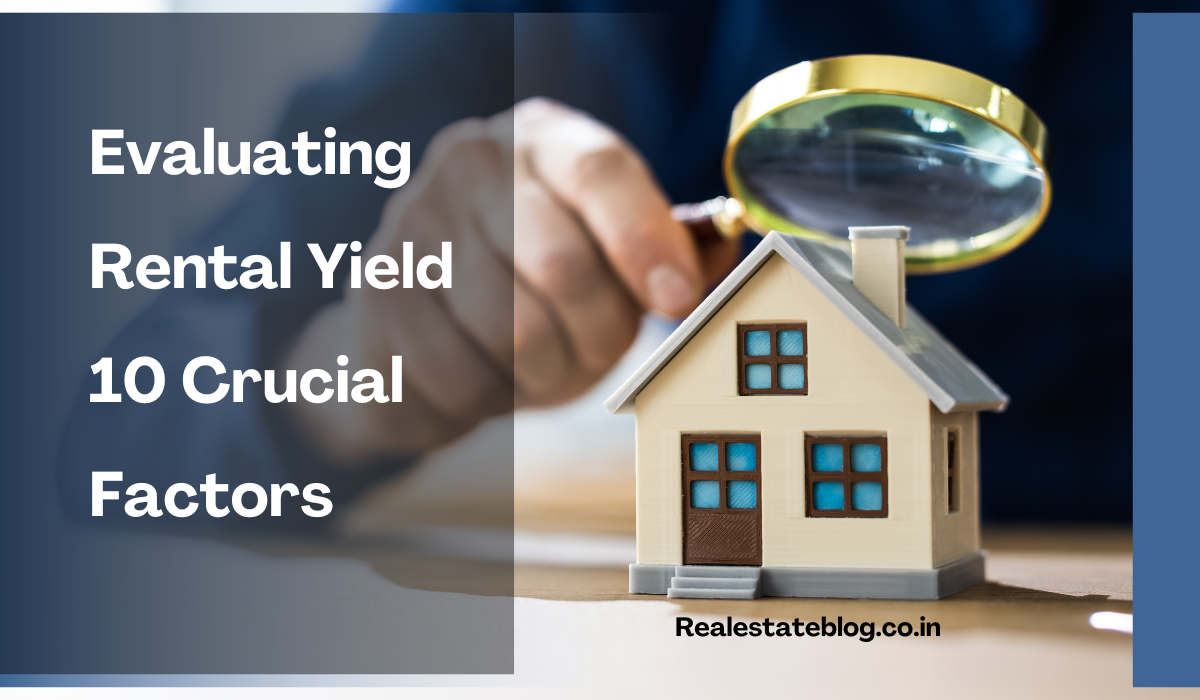Investing in rental properties has gained significant popularity in India, with investors seeking to generate passive income and build long-term wealth. However, before taking the plunge, it’s crucial to evaluate the rental yield India to ensure a profitable investment. Rental yield India is a key metric that measures the annual return on your investment, considering the property’s purchase price and the rental income it generates.
In this article, we’ll delve into 10 essential factors to consider when evaluating rental yield India before buying a property. By understanding these factors, you can make informed decisions and maximize your chances of success in the Indian real estate market.
Understanding Rental Yield in the Indian Context
Rental yield is the annual rental income generated by a property expressed as a percentage of the property’s purchase price or current market value. It is calculated using the following formula:
Rental Yield = (Annual Rental Income / Property Value) x 100
For example, if you purchase a property for Rs. 1 crore and it generates an annual rental income of Rs. 8 lakhs, the rental yield would be:
Rental Yield = (Rs. 8,00,000 / Rs. 1,00,00,000) x 100 = 8%
Unlock Your Dream Home Today!
Get personalized real estate insights delivered straight to your inbox.
It’s important to note that there are two types of rental yield:
- Gross Rental Yield: This is the yield calculated before deducting any expenses associated with the property, such as maintenance costs, property taxes, and insurance.
- Net Rental Yield: This is the yield calculated after deducting all expenses associated with the property. It provides a more accurate picture of the actual return on investment.
In the Indian context, rental yield varies across cities and localities. According to a report by ANAROCK Property Consultants, the average rental yields in major Indian cities range from 2.5% to 3.5% (Source: ANAROCK Rental Yield Report 2019). However, certain micro-markets and property types can offer higher yields.
Factor 1: Location Analysis in India
Location is one of the most critical factors influencing rental yield in India. Properties located in prime areas, with good connectivity, proximity to employment hubs, and access to amenities, tend to command higher rents and generate better yields.
For instance, in Bangalore, areas like Indiranagar, Koramangala, and Whitefield, which are close to IT parks and have good social infrastructure, often provide higher rental yields compared to peripheral locations.
When evaluating a property’s location, consider the following:
- Proximity to public transportation, major roads, and highways
- Access to schools, hospitals, shopping centers, and recreational facilities
- Distance from employment hubs and commercial centers
- Future development plans and infrastructure projects in the area
Conducting thorough research on the location, including an analysis of rental market trends, average rental prices, and occupancy rates, can help you make an informed decision.
Factor 2: Property Valuation in India
Accurate property valuation is essential to determine the fair market value and assess the potential rental yield of a property. Overvaluing a property can lead to lower yields, while undervaluing it may result in missed investment opportunities.
In India, there are several methods for property valuation:
- Sales Comparison Approach: This method involves comparing the subject property with similar properties recently sold in the same area. Factors like size, age, location, and amenities are considered to arrive at a fair market value.
- Income Approach: This method considers the property’s potential rental income and estimates its value based on the expected cash flows. It is commonly used for evaluating income-generating properties.
- Cost Approach: This method calculates the property’s value by estimating the cost of constructing a similar property from scratch, factoring in land value, construction costs, and depreciation.
Professional property valuers and real estate experts can provide accurate valuations based on these methods. It’s advisable to get a valuation report from a reputable source before making an investment decision.
Factor 3: Rental Income Potential in India
Estimating the potential rental income is crucial for calculating rental yield. Factors influencing rental income include:
- Property size and configuration (e.g., 1BHK, 2BHK, 3BHK)
- Property type (e.g., apartment, villa, townhouse)
- Amenities and facilities provided (e.g., parking, security, swimming pool)
- Quality of construction and finishes
- Demand and supply dynamics in the local rental market
To estimate the rental income, research the average rental prices for similar properties in the area. Online property portals, local real estate agents, and property management companies can provide valuable insights.
For example, if you’re considering investing in a 2BHK apartment in Gurgaon, you can look at the average rental prices for similar properties in the locality. If the average rent is Rs. 25,000 per month, you can estimate an annual rental income of Rs. 3,00,000.
It’s also important to consider the rent growth potential in the area. Cities with strong economic growth, job creation, and population migration tend to have better rent growth prospects. A report by Knight Frank India suggests that rental prices in major Indian cities like Bangalore, Delhi, and Mumbai are expected to grow by 3-5% annually in the coming years (Source: Knight Frank India Residential Market Report 2021).
Factor 4: Operating Expenses in India
To calculate the net rental yield, it’s essential to factor in the operating expenses associated with the property. Common operating expenses in India include:
- Property taxes: These vary by state and municipal jurisdiction. In cities like Mumbai, property taxes can be as high as 30-40% of the annual rental value.
- Maintenance charges: These include regular upkeep, repairs, and society maintenance fees. They can range from Rs. 2-5 per square foot per month, depending on the property type and amenities provided.
- Insurance: Landlords should consider getting property insurance to protect against damages and liabilities. Insurance premiums can vary based on the property value and coverage.
- Property management fees: If you hire a property management company to handle tenant screening, rent collection, and maintenance, their fees can be around 8-12% of the monthly rental income.
For instance, let’s say you purchase a 1,000 square foot apartment in Pune for Rs. 80 lakhs, and it generates a monthly rental income of Rs. 25,000. The annual operating expenses might look like this:
- Property taxes: Rs. 50,000
- Maintenance charges: Rs. 36,000 (at Rs. 3 per sq. ft. per month)
- Insurance: Rs. 10,000
- Property management fees: Rs. 36,000 (at 12% of monthly rent)
- Total annual operating expenses: Rs. 1,32,000
The net rental yield would be:
Net Rental Yield = ((Annual Rental Income – Operating Expenses) / Property Value) x 100
= ((Rs. 3,00,000 – Rs. 1,32,000) / Rs. 80,00,000) x 100
= 2.1%
Factor 5: Vacancy Rates in Indian Cities
Vacancy rates refer to the percentage of time a rental property remains unoccupied. High vacancy rates can significantly impact rental yields, as they result in loss of rental income.
In India, vacancy rates vary across cities and localities. According to a report by ANAROCK Property Consultants, the average vacancy rates in major Indian cities range from 10% to 20% (Source: ANAROCK Rental Yield Report 2019). However, some micro-markets and property types may have lower vacancy rates due to high demand.
To assess the vacancy risk, consider the following:
- Demand and supply dynamics in the local rental market
- Economic and job market conditions in the city
- Seasonal fluctuations in rental demand (e.g., academic year for student housing)
- Competition from other rental properties in the area
Strategies to minimize vacancy periods include:
- Pricing the rent competitively based on market rates
- Offering attractive amenities and facilities to tenants
- Maintaining the property in good condition
- Effective marketing and advertising to reach potential tenants
- Thorough tenant screening to ensure reliable and long-term occupancy
Factor 6: Mortgage Payments in India
If you’re financing your rental property purchase with a home loan, mortgage payments can have a significant impact on your rental yield. Higher mortgage payments can lower your net yield, while lower payments can improve it.
To calculate the rental yield considering mortgage payments, use the following formula:
Rental Yield (with mortgage) = ((Annual Rental Income – Operating Expenses – Annual Mortgage Payments) / Property Value) x 100
For example, let’s say you purchase a property in Bangalore for Rs. 1 crore, with a home loan of Rs. 80 lakhs at an interest rate of 8% per annum for a tenure of 20 years. The property generates an annual rental income of Rs. 8 lakhs, and the annual operating expenses are Rs. 1.5 lakhs.
The annual mortgage payment would be approximately Rs. 7.7 lakhs (calculated using an EMI calculator).
Rental Yield (with mortgage) = ((Rs. 8,00,000 – Rs. 1,50,000 – Rs. 7,70,000) / Rs. 1,00,00,000) x 100
= -1.2%
In this case, the rental yield is negative due to the high mortgage payments. To improve the yield, you can consider:
- Negotiating for a lower interest rate or longer repayment tenure on your home loan
- Making a larger down payment to reduce the loan amount
- Increasing the rental income by providing additional amenities or services
- Investing in a property with a higher rental yield potential
Factor 7: Cash Flow Analysis for Indian Properties
Conducting a thorough cash flow analysis is essential to assess the profitability and sustainability of a rental property investment. A cash flow statement helps you understand the inflows (rental income) and outflows (expenses) associated with the property.
Here’s an example of a simple cash flow statement for a rental property in India:
| Particulars | Monthly | Annually |
|---|---|---|
| Rental Income | 25,000 | 3,00,000 |
| Less: Operating Expenses | ||
| – Property Taxes | 4,000 | 48,000 |
| – Maintenance Charges | 3,000 | 36,000 |
| – Insurance | 1,000 | 12,000 |
| – Property Management Fees | 3,000 | 36,000 |
| Total Operating Expenses | 11,000 | 1,32,000 |
| Less: Mortgage Payments (if any) | 35,000 | 4,20,000 |
| Net Cash Flow | -21,000 | -2,52,000 |
In this example, the property generates a monthly rental income of Rs. 25,000 but has operating expenses of Rs. 11,000 and a monthly mortgage payment of Rs. 35,000. As a result, the net cash flow is negative, indicating that the property is not profitable in the short term.
However, it’s important to consider the long-term appreciation potential of the property and the possibility of increasing rental income over time. A negative cash flow in the initial years may be offset by capital appreciation and higher rental yields in the future.
Factor 8: Appreciation Potential in the Indian Market
While rental yield is a crucial factor, the appreciation potential of a property should also be considered when making an investment decision. In India, property prices have historically shown an upward trend, driven by factors like economic growth, urbanization, and infrastructure development.
According to the National Housing Bank’s (NHB) House Price Index, residential property prices in India have grown at a compound annual growth rate (CAGR) of around 10-12% over the past decade (Source: NHB Residex). However, the appreciation potential varies across cities and micro-markets.
Factors influencing appreciation potential include:
- Economic and job market growth in the city
- Infrastructure development and connectivity
- Demand and supply dynamics in the local real estate market
- Government policies and regulations affecting the sector
- Future development plans and land use changes in the area
For example, if you invest in a property in a rapidly developing suburb of Hyderabad, with upcoming metro connectivity and IT parks, the appreciation potential may be higher compared to a saturated locality in the city center.
It’s essential to balance rental yield and appreciation potential based on your investment goals and risk appetite. If your primary goal is regular rental income, a property with a high rental yield may be more suitable. On the other hand, if you’re looking for long-term capital appreciation, a property with lower rental yield but higher growth prospects may be a better choice.
Factor 9: Rental Demand in Indian Cities
Rental demand is a key driver of rental yield and occupancy rates. Cities with strong rental demand tend to have lower vacancy rates and higher rental yields.
Factors influencing rental demand in Indian cities include:
- Economic and job market growth
- Population migration and urbanization
- Presence of educational institutions and student population
- Proximity to employment hubs and commercial centers
- Availability of social infrastructure and amenities
According to a report by PropTiger, the top Indian cities for rental demand are Bangalore, Mumbai, Pune, Chennai, and Hyderabad, driven by their strong IT and services sectors (Source: PropTiger Rental Demand Report 2020).
When evaluating rental demand, consider the following:
- Demographic profile of the area (e.g., working professionals, students, families)
- Average occupancy rates and time-to-rent for similar properties in the locality
- Rental demand seasonality (e.g., peak seasons for student housing or corporate rentals)
- Upcoming infrastructure projects or economic drivers that may impact rental demand
For instance, if you’re investing in a rental property near an IT park in Pune, the rental demand is likely to be high, as there is a constant influx of working professionals seeking housing close to their workplaces.
Factor 10: Legal and Regulatory Considerations in India
Navigating the legal and regulatory landscape is crucial when investing in rental properties in India. Some key considerations include:
- Property title and ownership: Ensure that the property has a clear and marketable title, free from any encumbrances or disputes. Conduct a thorough title search and due diligence before making a purchase.
- Registration and stamping: Property transactions in India require proper registration and stamping of sale deeds. Familiarize yourself with the registration process and associated costs in the state where the property is located.
- Rental agreements: Have a legally vetted rental agreement that clearly outlines the terms and conditions of the tenancy, including rent, security deposit, maintenance responsibilities, and termination clauses.
- Taxation: Understand the tax implications of rental income, such as income tax, property tax, and capital gains tax. Consult with a tax professional to optimize your tax liabilities and claim eligible deductions.
- Rent control laws: Some states in India have rent control laws that cap the rent and regulate tenant eviction. Research the local rent control regulations and their potential impact on your investment.
- RERA compliance: The Real Estate (Regulation and Development) Act, 2016 (RERA) aims to protect the interests of buyers and promote transparency in the real estate sector. Ensure that the property is RERA-compliant and the developer has obtained all necessary approvals.
For example, if you’re buying a property in Maharashtra, you need to register the sale deed and pay stamp duty of around 5-7% of the property value. Additionally, if the property is located in a rent-controlled area, you may face restrictions on rent increases and tenant eviction.
Evaluating rental yield is a critical step in making informed decisions when investing in rental properties in India. By considering factors such as location, property valuation, rental income potential, operating expenses, vacancy rates, mortgage payments, cash flow, appreciation potential, rental demand, and legal and regulatory aspects, you can assess the viability and profitability of a rental property investment.
It’s essential to conduct thorough research, analyze data from reliable sources, and seek professional advice from real estate experts, financial advisors, and legal consultants. Remember, investing in real estate is a long-term commitment, and it’s crucial to have a well-defined investment strategy aligned with your financial goals and risk tolerance.
By understanding and applying these factors, you can make sound investment decisions and maximize your chances of success in the Indian rental property market.
If you found this article informative and want to learn more about rental property investment in India, visit our website https://realestateblog.co.in for a wealth of resources, expert insights, and success stories. Subscribe to our newsletter to stay updated on the latest trends, investment opportunities, and market analysis in the Indian real estate sector.
For personalized guidance on your rental property investment journey, schedule a consultation with our experienced team of real estate professionals.
Rental yield is the annual rental income generated by a property expressed as a percentage of the property's purchase price or current market value. It can be calculated using the formula: Rental Yield = (Annual Rental Income / Property Value) x 100.
The two types of rental yield are Gross Rental Yield, which is calculated before deducting any expenses, and Net Rental Yield, which is calculated after deducting all property-related expenses.
Location is critical as properties in prime areas with good connectivity and access to amenities tend to command higher rents and generate better yields compared to peripheral locations.
Factors influencing rental income include property size and configuration, property type, amenities provided, quality of construction, and demand and supply dynamics in the local rental market.
Common operating expenses include property taxes, maintenance charges, insurance, and property management fees. These need to be deducted from the rental income to calculate net rental yield.
High vacancy rates can significantly impact rental yields by resulting in loss of rental income. It's important to assess local demand and supply dynamics to understand vacancy risks.
A thorough cash flow analysis should include rental income, operating expenses, and any mortgage payments to assess the profitability and sustainability of the investment.
Appreciation potential is important as it reflects the expected increase in property value over time, influenced by economic growth, urbanization, and infrastructure development.
Factors influencing rental demand include economic growth, population migration, proximity to employment hubs, the presence of educational institutions, and availability of social infrastructure.
Investors should ensure clear property title, understand registration and stamping requirements, have legally vetted rental agreements, and be aware of taxation and local rent control laws.
DISCLAIMER
The information provided on this website is for general informational purposes only. While we strive to keep the content up-to-date and accurate, we make no representations or warranties of any kind, express or implied, about the completeness, accuracy, reliability, suitability, or availability of the information, products, services, or related graphics contained on this website.
In no event will we be liable for any loss or damage including without limitation, indirect or consequential loss or damage, or any loss or damage whatsoever arising from loss of data or profits arising out of, or in connection with, the use of this website.
Real Estate Investment Risks
Real estate investments involve significant risks and market volatility. Property values, rental rates, and market conditions can fluctuate. Past performance is not indicative of future results.
Before Making Real Estate Decisions
Before making any real estate decision, we strongly advise you to:
- Conduct thorough due diligence
- Consult with qualified legal, financial, and real estate professionals
- Carefully review all relevant documents and contracts
- Consider your personal financial situation and investment goals
This website does not provide legal, financial, or investment advice. All content is for informational purposes only and should not be construed as professional advice or recommendations.
By using this website, you acknowledge and agree to these terms. We reserve the right to modify this disclaimer at any time without notice.







